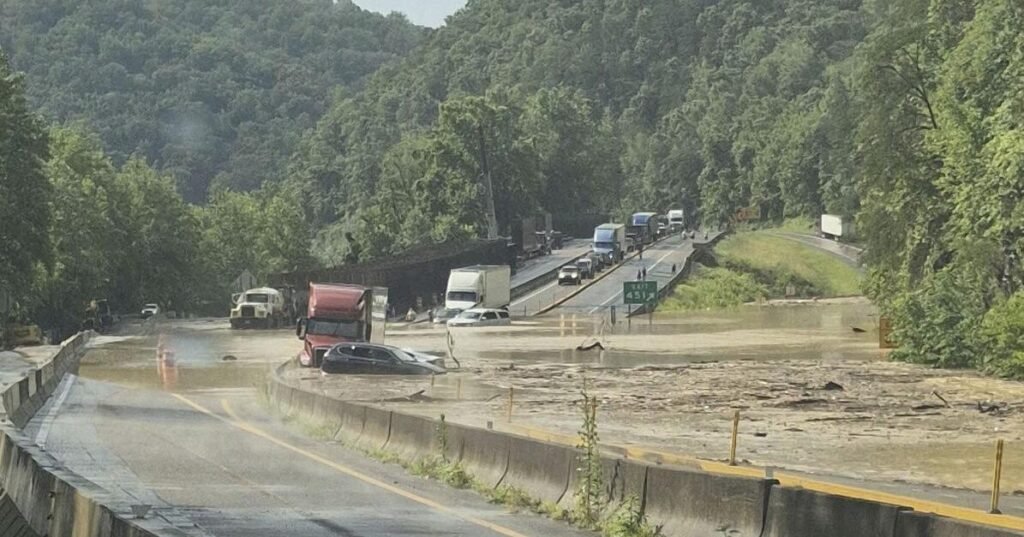I-40 Reopens in the Smokies: Navigating Nature’s Force in Tennessee’s Mountain Corridor
When it comes to the majestic Great Smoky Mountains, Mother Nature occasionally reminds us who’s really in charge. As someone who’s spent years exploring these ancient hills and writing about their magnificence, I’ve seen firsthand how quickly conditions can change in this rugged landscape. The recent closure of Interstate 40 through the narrow mountain corridor is yet another chapter in the ongoing dialogue between human infrastructure and natural forces.
What Happened on I-40 in the Smokies?
On Friday, crews successfully reopened a section of Interstate 40 that runs through the Great Smoky Mountains after it was closed due to significant flooding and a rock slide. This vital transportation artery, which winds through one of the most scenic yet challenging terrains in the Eastern United States, had been impassable, creating logistical challenges for travelers and freight moving between Tennessee and North Carolina.
The closure occurred near Hartford, Tennessee, a small community nestled at the edge of the Great Smoky Mountains National Park. The combination of heavy rainfall and the inherently unstable mountainous terrain triggered both flooding and the rock slide that made the roadway unsafe for travel.

Why Does I-40 Through the Smokies Experience These Issues?
Having written about this region for years, I can tell you this isn’t the first time I-40 has faced such challenges. The geography here creates a perfect storm of conditions for these events:
- Steep mountain slopes that rise dramatically from the roadway
- The Pigeon River gorge which constrains both the river and roadway into a narrow passage
- Weather patterns that can bring intense rainfall to the region
- Geological composition that includes various rock types prone to erosion and slides
I’ve driven this stretch countless times, and each journey reminds me of the engineering marvel it represents while also respecting the power of the landscape it traverses.
Historical Context of I-40 Challenges
This section of I-40 has a long history of closures due to rock slides and flooding. The most notable in recent memory occurred in October 2009, when a massive rock slide near the North Carolina-Tennessee border closed the interstate for several months. That event required extensive reconstruction and rock stabilization efforts.
What makes this corridor so essential yet so vulnerable is its role as one of the few major east-west routes through the Appalachian Mountains in this region. When I-40 closes here, detours can add hours to travel times, affecting everything from commercial shipping to tourist access.
| Major I-40 Closures in the Smokies | Duration | Impact |
|---|---|---|
| October 2009 | 6 months | Complete closure requiring $12.9 million in repairs |
| January 2013 | 1 week | Partial closure with single-lane traffic |
| February 2019 | 2 weeks | Complete closure near the NC/TN line |
| Current incident | Several days | Complete closure near Hartford, TN |
What This Means for Travelers and Locals
The reopening of I-40 comes as a significant relief to both locals and travelers. As someone who cherishes this region, I’ve seen how these closures affect the communities that depend on tourism and transportation. When the interstate closes, the economic impact ripples through small mountain towns that rely on visitor traffic.
For travelers planning to visit the Great Smoky Mountains National Park—America’s most visited national park—this reopening means restored access to one of the nation’s natural treasures. The park itself remains a stunning testament to conservation efforts, with over 800 miles of hiking trails and unparalleled biodiversity.
Tips for Safe Travel Through the Smoky Mountain Corridor
If you’re planning to travel through this section of I-40, here are some recommendations I’ve gathered from years of mountain driving:
- Check road conditions before departing through TDOT’s SmartWay system
- Be prepared for sudden weather changes, especially during spring and summer storm seasons
- Keep extra water, snacks, and emergency supplies in your vehicle
- Use caution when driving after heavy rainfall, as conditions can change rapidly
- Consider alternative routes during periods of heavy rain or when warnings are issued
The Ongoing Balance Between Nature and Infrastructure
What I find most fascinating about these events is how they highlight the ongoing negotiation between human infrastructure needs and the powerful natural forces at work in the Smokies. Engineers and maintenance crews work tirelessly to maintain this crucial transportation link, even as the mountains continue their slow but relentless geological processes.
The Tennessee Department of Transportation (TDOT) has implemented various mitigation strategies over the years, including rock bolting, mesh installations, and monitoring systems. Yet the mountains remain dynamic, changing with each heavy rain and freeze-thaw cycle.
Looking Forward: Resilience in the Smokies
As we see I-40 reopen once again, I’m reminded of the resilience both of this mountain landscape and the communities that call it home. The Smoky Mountains have stood for millions of years and will continue to evolve long after our highways are gone.
For now, travelers can once again enjoy the breathtaking journey through one of America’s most scenic interstate corridors. The views of mist-covered mountains, the rushing Pigeon River, and the dense forests make this stretch of highway worth the occasional inconvenience of nature’s reminders of who’s really in charge.
If you’re heading to the Smokies soon, take a moment to appreciate not just the natural beauty, but also the engineering and maintenance work that makes your journey possible. And perhaps slow down just a bit to truly absorb the majesty of this special place that I’ve come to love through years of exploration and writing.
HARTFORD, Tenn. (AP) — Crews on Friday reopened a section of Interstate 40 along its narrow corridor through the Great Smoky Mountains after flooding and a rock slide closed the Source link

